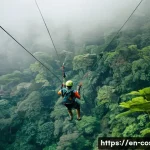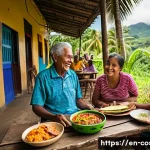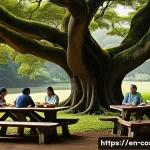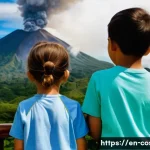Oh, Costa Rica! Just hearing the name conjures images of vibrant rainforests, crashing waves, and that incredible ‘Pura Vida’ spirit. I remember my first trip, desperately trying to figure out the “perfect” time to go.
It felt like an impossible puzzle, especially with all the talk about dry seasons versus green seasons, and trying to align it with specific activities like surfing Tamarindo or spotting quetzals in Monteverde.
What I’ve personally found, and what recent travel trends strongly suggest, is that the ‘best’ time is really a matter of what you’re hoping to experience.
Forget rigid calendars; these days, smart travelers are looking beyond just avoiding rain. With climate patterns shifting and sustainable tourism becoming a huge focus, the traditional shoulder seasons are gaining massive popularity.
For example, if you’re keen on seeing the rainforest truly alive and don’t mind a refreshing afternoon shower, the green season (often cheaper!) offers an unbelievable immersion into nature, and you’ll find fewer crowds vying for the same perfect photo op.
It’s a different kind of magic, one I truly embraced on my last visit, realizing how much more authentic the experience felt away from peak-season buzz.
And let’s be honest, those vibrant green hues after a fresh rain are something else entirely. Picking your Costa Rican adventure season wisely can drastically impact everything from wildlife sightings to your budget, and even how much you truly connect with the local culture.
It’s not just about sunshine anymore; it’s about aligning your desires with the country’s dynamic pulse. Let’s delve deeper into the details.
Unpacking the Dry Season: Sunshine, Surfing, and Popular Peaks
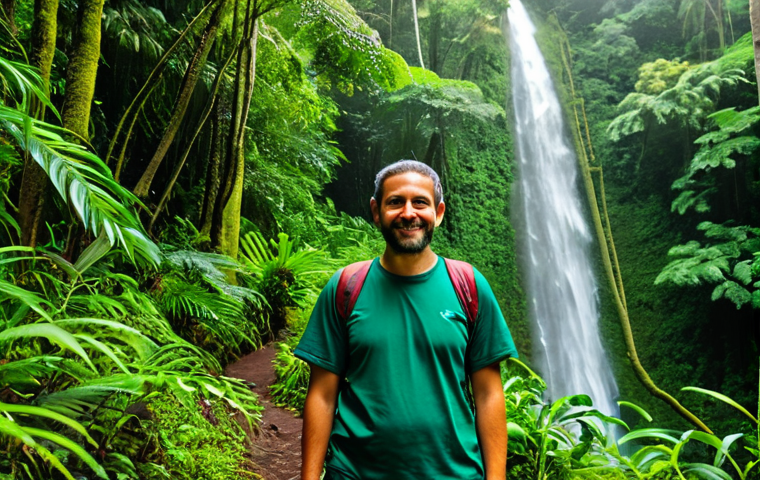
For many, the idea of a Costa Rican getaway immediately brings to mind endless sunshine, and that’s precisely what the dry season, running roughly from December through April, typically delivers.
I remember my first time planning a trip, the allure of perfect beach days and clear skies was undeniable. You’ll find yourself basking in glorious warmth, especially along the Pacific coast where places like Guanacaste and Nicoya Peninsula become sun-drenched havens.
This is prime time for those iconic beach experiences: learning to surf in Tamarindo, snorkeling off the coast of Conchal, or simply soaking up the rays in Manuel Antonio.
However, I quickly learned that this popularity comes with its own set of trade-offs. While the weather is consistently beautiful, you’re also sharing paradise with more travelers.
This means higher prices for everything from flights and accommodations to tours, and popular spots can feel quite bustling. Despite the crowds, the energy is infectious, and the sheer reliability of the weather makes it ideal for anyone prioritizing outdoor activities without the worry of rain interrupting their plans.
It’s also when the Pacific waters are at their calmest and clearest, making it perfect for diving and snorkeling excursions that offer incredible visibility of marine life.
1. Surfing the Pacific Swells and Beach Bliss
When the dry season arrives, the Pacific coast truly comes alive. I’ve always been drawn to the ocean, and the consistent, clean swells that roll into breaks like those around Santa Teresa and Pavones during these months are a surfer’s dream.
It’s not just for the pros; even if you’re a beginner, the conditions are often ideal for learning, with plenty of surf schools readily available. Imagine waking up to the sound of waves, grabbing your board, and paddling out into the warm Pacific, with the sun already high in the sky.
Beyond surfing, the beaches themselves are a major draw. Think long stretches of golden sand, perfect for morning runs, horseback riding at sunset, or simply lounging with a good book.
Towns like Jacó and Tamarindo buzz with activity, offering a vibrant nightlife and a wide array of dining options, from casual beachfront eateries to upscale gourmet restaurants.
While the dry season offers less dramatic rainfall, it’s essential to remember that even then, microclimates exist; you might encounter a brief shower in the mountains, but generally, the coastal areas remain sunny and inviting.
I remember one particularly perfect day in Nosara, where the air was crisp, the ocean inviting, and the only decision I had to make was whether to surf, practice yoga, or just relax in a hammock.
That’s the dry season magic.
2. Navigating Dry Season Crowds and Costs
My initial trips to Costa Rica during the dry season taught me a valuable lesson: plan ahead, especially if you’re on a budget or prefer solitude. This is peak tourism season, and for good reason – the weather is reliably stunning.
However, this means that accommodation prices, flight costs, and even tour rates can significantly increase, sometimes by 30-50% compared to other times of the year.
Popular national parks like Manuel Antonio and Arenal can get quite crowded, with lines forming at entrances and trails feeling a bit more congested. If you’re hoping for a quiet, secluded experience with abundant wildlife sightings that aren’t hampered by other tourists, this might not be your ideal window.
Booking well in advance is non-negotiable for hotels and popular tours, particularly if you’re traveling during major holidays like Christmas, New Year’s, or Easter.
I learned this the hard way trying to find a last-minute room in La Fortuna during Semana Santa – it was nearly impossible! While the crowds can be a slight deterrent for some, the vibrant atmosphere and the sheer number of activities available often make up for it.
It’s a trade-off: guaranteed sunshine and lively energy versus potentially higher costs and busier attractions. But if you value consistent good weather above all else, the dry season certainly delivers on that promise, making careful planning your best friend.
Embracing the Green Season: Lush Landscapes and Authentic Experiences
While the dry season is often lauded for its perfect beach weather, my personal preference, and what I’ve truly come to appreciate, is the “green season.” Running roughly from May to November, this period is often mislabeled as the “rainy season,” which sounds far more ominous than it actually is.
What you’ll mostly experience are sunny mornings followed by afternoon showers that replenish the landscape, transforming it into an incredibly vibrant, almost impossibly green paradise.
The air feels cleaner, the dust settles, and the entire country bursts with life. This is when the rainforests are at their most magnificent, the rivers swell for exhilarating whitewater rafting, and the waterfalls are at their most powerful and majestic.
I remember seeing a waterfall in Bajos del Toro during the green season, and it was simply breathtaking – a roaring cascade of white water against an emerald backdrop.
It’s a completely different Costa Rica, one that feels more alive, more authentic, and often, more affordable. Plus, the wildlife tends to be more active and visible after a refreshing rain, and the fewer crowds mean you get to experience the natural beauty in a much more intimate way.
1. Unveiling the Rainforest’s Verdant Heart
If your dream Costa Rican adventure involves truly immersing yourself in the country’s unparalleled biodiversity, then the green season is your calling.
This is when the rainforests, from Monteverde’s cloud forests to the lowlands of Corcovado, truly live up to their name. I’ve walked through these forests in the dry season, and while beautiful, they don’t hold a candle to the vibrant, dripping, utterly alive feeling you get during the green season.
The vegetation is incredibly lush, every leaf seems to glow with an intense emerald hue, and the air is thick with the scent of damp earth and blooming flowers.
This abundance of life attracts a wider array of wildlife. You’ll often find monkeys more active, sloths more visible, and a greater chance of spotting exotic birds like the resplendent quetzal, particularly as the fruiting season kicks into full gear.
Remember that “rain” often means a refreshing afternoon shower, not an all-day deluge. These brief downpours cool the air and nourish the ecosystem, leaving behind a sparkling, vibrant landscape.
I found that mornings are usually clear, perfect for hiking and exploring, and by the time the rain rolls in, you’re often ready for a siesta or a warm cup of coffee anyway.
It’s an immersive, sensory experience that truly connects you with the heart of Costa Rica’s natural world.
2. The Art of Off-Peak Travel: Budget-Friendly Bliss and Tranquility
One of the most compelling reasons to visit Costa Rica during the green season, in my humble opinion, is the significant reduction in crowds and costs.
This is where your travel budget can really stretch further. Airlines often offer better deals on flights, and hotels, tours, and car rentals typically drop their prices considerably, sometimes by 20-40%.
I’ve personally saved hundreds of dollars on accommodation alone by choosing to travel in the “off-season.” This means you can often afford a nicer hotel, extend your stay, or simply reallocate those savings to more activities or delicious local meals.
Beyond the financial benefits, the reduced tourist traffic means a more peaceful and authentic experience. National parks are less crowded, allowing for more intimate wildlife encounters and a greater sense of solitude on hiking trails.
You’ll find it easier to book popular excursions, and local guides have more time to share their knowledge and stories with you. The pace feels slower, more “Pura Vida.” It’s also an excellent time to engage with local communities, as they’re less overwhelmed by tourists, offering a deeper cultural immersion.
If you crave tranquility, want your money to go further, and appreciate a vibrant, lush landscape, the green season is an absolute win.
Strategizing Shoulder Seasons: The Best of Both Worlds
For those who, like me, are constantly seeking that sweet spot—a balance between good weather, fewer crowds, and reasonable prices—the shoulder seasons are where the magic truly happens in Costa Rica.
These are typically late April to early May and November, bridging the dry and green seasons. It’s a fascinating time when the country is transitioning, offering glimpses of both peak season brilliance and off-peak tranquility.
You might experience the tail end of the dry season’s consistent sunshine or the very beginning of the green season’s refreshing afternoon showers, often with the added benefit of reduced tourist traffic and more attractive prices.
My last trip was in early May, and I found the weather to be delightfully cooperative, with mostly sunny mornings and just enough rain in the afternoons to make everything feel fresh and alive without disrupting plans.
It felt like I had unlocked a secret window into Costa Rica, experiencing its vibrant beauty without the intense competition for resources or the hustle and bustle of peak times.
It’s a strategic choice for savvy travelers who are willing to embrace a little unpredictability for a significant payoff.
1. Capitalizing on Transitioning Weather and Thriving Wildlife
The shoulder seasons are a meteorological lottery that often pays off handsomely. In late April and early May, you’re catching the tail end of the dry season’s bright skies, but with a noticeable shift as the landscape begins to green up with the first signs of rain.
In November, it’s the opposite – the heavy rains of the green season are winding down, and sunny days become more frequent, signaling the dry season’s approach.
This transitional period often means you get the best of both worlds: good weather for activities, but with a refreshing lushness that’s missing from the bone-dry peak season.
I’ve noticed wildlife seems particularly active during these times, possibly due to the changing food sources and water availability. For example, during my November visit, the birdwatching in Monteverde was exceptional, with migratory species making their appearance and resident birds more visible.
The rivers, after months of rain, are often at their perfect level for whitewater rafting, offering exhilarating adventures without the overwhelming torrents of the peak green season.
It’s a time when Costa Rica truly feels like a living, breathing ecosystem in flux, offering unique opportunities for observation and exploration that you simply don’t get when the weather patterns are more fixed.
2. The Savvy Traveler’s Financial Edge
One of the most compelling arguments for embracing the shoulder seasons is the significant financial advantage. Airlines, hotels, and tour operators are eager to fill their capacities during these transitional periods, meaning you’ll often find prices that are considerably lower than the peak dry season, yet higher than the absolute lowest points of the green season.
It’s a sweet spot where value meets availability. I managed to snag a fantastic deal on a boutique hotel in La Fortuna during early May that would have been well out of my budget just a few weeks earlier.
These savings can make a substantial difference to your overall trip cost, allowing you to splurge on experiences you might otherwise have to skip, like a thrilling zip-lining adventure, a relaxing hot springs visit, or a multi-day trek.
Furthermore, with fewer tourists, you’ll likely find more flexibility with last-minute bookings and a more personalized experience with local operators.
If you’re a flexible traveler who prioritizes value and a slightly less crowded experience without completely sacrificing good weather, then timing your trip for the shoulder seasons is a shrewd move that can truly elevate your Costa Rican adventure.
Timing Your Trip for Specific Activities and Wildlife Encounters
While general seasonal patterns are important, my experience has taught me that truly optimizing your Costa Rica trip often means aligning it with specific activities or the best times to witness particular wildlife events.
Costa Rica’s microclimates and diverse ecosystems mean that what’s ideal for one pursuit might be less so for another. For example, the best time to see nesting sea turtles is entirely different from the prime season for whale watching or tackling the most challenging whitewater rapids.
It’s about being intentional with your travel dates, rather than just hoping for the best. I remember one trip where my sole focus was seeing humpback whales; researching their migration patterns was crucial, and it paid off with unforgettable sightings.
This kind of targeted planning can make the difference between a good trip and an absolutely phenomenal one, ensuring you tick off those bucket-list items with the highest probability of success.
It means looking beyond just sunshine and rain and understanding the specific rhythms of Costa Rica’s incredible natural world and adventure offerings.
1. Surfing and Beach Activities: Ride the Right Wave
For surf enthusiasts, the “best” time depends heavily on your skill level and desired wave conditions. As I mentioned, the dry season (December-April) generally offers smaller, cleaner, and more consistent waves on the Pacific coast, ideal for beginners and longboarders.
The winds are often offshore, creating perfect glassy conditions. However, if you’re an experienced surfer chasing bigger swells, the green season (May-November) can deliver more powerful waves, especially from May to July when the south swells become more prominent along the Pacific coast.
Places like Pavones and Witches Rock become legendary for their impressive breaks. On the Caribbean side, the surf season is generally from November to May, with January to March being peak for big swells.
For general beach relaxation and swimming, the dry season on the Pacific side is undoubtedly more reliable for sunshine. But for a broader range of water sports, including snorkeling and diving, the green season can offer surprising clarity in certain areas once the rain has settled, especially after the initial downpours have cleared sediment.
I’ve found that some of my most memorable snorkeling experiences have been during the tail end of the green season, as the marine life flourishes after the rains.
2. Wildlife Watching: When to Spot Costa Rica’s Icons
Costa Rica is a wildlife paradise, but timing is key for specific sightings. 1. Whale Watching: Humpback whales visit Costa Rica’s Pacific coast twice a year.
* Northern Hemisphere Humpbacks: December to April (peak Feb-March). * Southern Hemisphere Humpbacks: July to November (peak Aug-Oct). * The Osa Peninsula and Marino Ballena National Park are prime spots.
I remember the sheer awe of seeing a mother whale and calf breach near Uvita during an August trip – an unforgettable moment. 2. Sea Turtle Nesting: This is highly seasonal and location-dependent.
* Green Sea Turtles: Tortuguero National Park, July to October (peak August-September). * Leatherback Sea Turtles: Gandoca-Manzanillo (Caribbean), February to May; Pacific coast (Playa Grande), October to March.
* Olive Ridley Sea Turtles: Ostional Wildlife Refuge, primarily July to December, with “arribadas” (mass nesting events) typically around the new moon.
Witnessing an arribada is a truly spectacular, once-in-a-lifetime experience. 3. Quetzals: These magnificent birds are best spotted during their breeding season, typically March to July, in cloud forest regions like Monteverde and San Gerardo de Dota.
I made a specific trip in April just for the quetzals, and the patience paid off when I finally saw one with its long tail feathers – absolutely magical.
4. Monkeys, Sloths, and Frogs: These are generally visible year-round, but the green season often brings them out more as the forests are lush and food is abundant.
Frogs, in particular, are more active and vocal after the rains. The table below provides a quick overview of some seasonal considerations:
| Activity/Wildlife | Ideal Season/Months | Notes & My Experience |
|---|---|---|
| Beach Lounging & Sunbathing | Dry Season (Dec-Apr) | Reliable sunshine, but more crowds. Perfect for a classic beach holiday. |
| Beginner Surfing (Pacific) | Dry Season (Dec-Apr) | Smaller, consistent waves; great for lessons. I found Tamarindo excellent for learning. |
| Advanced Surfing (Pacific) | Green Season (May-Nov) | Larger swells, especially May-July. Pavones becomes epic. |
| Whitewater Rafting | Green Season (May-Nov) | Higher river levels; more thrilling. My rafting trip on the Pacuare in July was incredible. |
| Humpback Whale Watching | Southern: Jul-Nov (Peak Aug-Oct); Northern: Dec-Apr (Peak Feb-Mar) | Crucial to plan around migration. Bahia Ballena during August felt truly special. |
| Sea Turtle Nesting (Green Turtles, Tortuguero) | Jul-Oct (Peak Aug-Sep) | A unique natural wonder. Must book tours in advance. |
| Quetzal Spotting | Mar-Jul | Cloud forest regions. Requires patience and a good guide. I finally saw one in Monteverde in April! |
| Hiking & Rainforest Exploration | Green Season (May-Nov) | Lush, vibrant landscapes, fewer crowds. Be prepared for mud and occasional rain. |
Budgeting Your Pura Vida: Seasonal Cost Insights
Understanding the financial implications of different travel seasons in Costa Rica is paramount, especially if you’re trying to make your Pura Vida dream a reality without breaking the bank.
From flights and accommodations to tours and even daily expenses, prices fluctuate dramatically depending on when you visit. My early trips taught me that a bit of strategic planning around these fluctuations could unlock significantly more experiences or allow for a longer stay.
It’s not just about avoiding the highest prices, but also understanding where you can get the best value for your money. I’ve often advised friends and family to consider the shoulder or green seasons if budget is a primary concern, as the savings can be truly substantial and free up funds for those unique experiences that make a trip unforgettable.
It’s about being a smart consumer in a thriving tourism economy, and knowing when to find the deals and when to brace for higher demand.
1. Flight and Accommodation Price Fluctuations
The most significant impact on your budget will undoubtedly come from flight and accommodation costs. During the dry season, particularly around major holidays like Christmas, New Year’s, and Easter, prices for flights from North America and Europe can skyrocket.
You’ll see premiums of 50-100% or more compared to off-peak times. Hotels, from luxury resorts to boutique eco-lodges, also implement their highest rates during this period, and availability becomes extremely limited.
Booking 6-12 months in advance is not uncommon for prime dry season travel. In contrast, the green season (May-November) sees a noticeable dip in prices.
Flights are generally more affordable, and hotels often offer attractive discounts and packages to entice travelers. I once found a deal on a stunning rainforest lodge in Arenal during September that was easily 30% less than its dry season rate – a total steal for the experience!
The shoulder seasons (late April/early May and November) offer a middle ground, with prices lower than peak but potentially higher than the deepest green season discounts.
Being flexible with your travel dates, even by a week or two, can make a monumental difference to your overall budget, allowing you to allocate those savings to richer experiences on the ground.
2. Tour and Daily Expense Considerations
Beyond flights and hotels, even daily expenses and tour prices can vary with the seasons. During the peak dry season, tour operators have less incentive to offer discounts, and popular excursions like zip-lining, whitewater rafting, or national park tours are often at their full price.
Transportation, too, can be slightly more expensive and crowded. Restaurants in tourist hotspots might charge a bit more, reflecting the high demand. However, during the green season, you’ll often find more flexibility with tour prices, and some operators might even offer slight discounts or package deals, especially for groups.
This is also when local eateries and markets might offer more competitive pricing as they cater more to local demand rather than overwhelming tourist traffic.
I’ve personally noticed that renting a car in the green season can be considerably cheaper, and the availability is much better, giving you more freedom to explore.
While the price differences on individual items like a meal might not seem huge, they add up over a week or two, making a noticeable impact on your overall expenditure.
Being mindful of these subtle shifts in pricing for everyday costs can help you manage your budget effectively and perhaps even extend your stay, allowing for more time to soak in that incredible ‘Pura Vida’ lifestyle.
Beyond the Brochure: Unique Seasonal Experiences
While the standard advice often revolves around dry versus green seasons, my extensive travels in Costa Rica have revealed that some of the most memorable and unique experiences are tied to very specific, often overlooked, seasonal nuances.
These are the moments that truly make a trip feel special and distinct from the typical tourist itinerary. It’s about delving deeper into the country’s rhythm and embracing opportunities that aren’t highlighted in every travel guide.
From witnessing specific cultural festivals to experiencing particular natural phenomena that occur only at certain times of the year, thinking beyond the conventional wisdom can lead to truly enriching encounters.
I’ve learned that some of the most profound connections I’ve made with local culture and nature came from being present during these unique seasonal moments, rather than just chasing perfect weather.
It’s these unexpected delights that truly etch Costa Rica into your memory, making each visit feel like a discovery.
1. Embracing Cultural Festivities and Local Rhythms
Costa Rica, like any country, has its own unique calendar of cultural events and holidays that can deeply enrich your travel experience if you time your visit accordingly.
Many of these, such as local fiestas patronales (patron saint festivals) or traditional bullfighting events, often occur outside the peak dry season, offering a more authentic glimpse into local life.
I remember stumbling upon a vibrant local festival in a small town near San Isidro de El General during a green season trip, complete with traditional music, dancing, and delicious local food.
It was an unplanned delight and a highlight of my journey, far more memorable than just another beach day. The dry season brings major national holidays like Christmas and Easter (Semana Santa), which are profoundly important and celebratory, but also mean most local businesses shut down and travel within the country can be extremely challenging due to high demand and packed buses.
On the other hand, the shoulder and green seasons often host specific agricultural festivals, coffee harvest celebrations, or environmental awareness events that you wouldn’t find otherwise.
Engaging with these local rhythms and celebrations allows for a much richer cultural immersion, moving beyond the curated tourist experience to truly connect with the heart and soul of the communities you visit.
2. Unique Natural Phenomena and Sensory Delights
Beyond the standard wildlife spotting, Costa Rica offers a kaleidoscope of natural phenomena that are highly seasonal and incredibly rewarding to witness.
For instance, the “arribadas” of Olive Ridley sea turtles at Ostional, where thousands of turtles come ashore to nest simultaneously, are a green season (July-December) spectacle that defies description.
I was fortunate enough to witness one, and the sheer scale and primal beauty of it left me speechless. Then there’s the incredible bioluminescence in certain bays, like those near Paquera or Puerto Escondido, which can be seen year-round but is often most vibrant on moonless nights, especially during the wetter months when the plankton populations might be more prolific.
Imagine paddling through water that lights up with every stroke! The dry season, while hot, is prime for witnessing the incredible migrations of various bird species, particularly along the Pacific flyways.
And let’s not forget the sensory experience of the green season itself: the fresh smell of rain on the rainforest floor, the vibrant sounds of frogs and insects after a downpour, and the visual feast of every shade of green imaginable.
These aren’t just things to see; they are experiences to feel and absorb, offering a deeper connection to Costa Rica’s wild heart. By considering these unique, season-specific wonders, you can transform your trip into something truly extraordinary.
Concluding Thoughts
Ultimately, the “best” time to visit Costa Rica isn’t a one-size-fits-all answer; it truly hinges on what you prioritize for your Pura Vida adventure. Whether you’re chasing guaranteed sunshine and vibrant crowds, seeking lush rainforest tranquility and budget-friendly bliss, or strategically aiming for that sweet shoulder-season spot, Costa Rica offers incredible experiences year-round. My hope is that by understanding these seasonal nuances, you can tailor your trip to perfectly match your dreams, ensuring every moment is as enriching and unforgettable as the last. Embrace the rhythm of this incredible country, and it will undoubtedly embrace you back.
Useful Information to Know
1. Currency & Payments: While the local currency is the Costa Rican Colón (CRC), US Dollars (USD) are widely accepted, especially in tourist areas. It’s always good to have some colones for smaller purchases or local sodas (eateries). Credit cards are accepted in most hotels and larger restaurants, but cash is king for markets and smaller vendors.
2. Transportation: Renting a 4×4 vehicle is often recommended, especially if you plan to explore remote areas or travel during the green season when roads can get muddy. Public buses are affordable but slower. Shared shuttles offer a convenient middle ground, and domestic flights can save significant travel time between distant regions.
3. Connectivity: Wi-Fi is generally available in hotels and many restaurants. Consider purchasing a local SIM card (from Kolbi, Movistar, or Claro) upon arrival for easy navigation and communication. Data plans are relatively inexpensive and provide excellent coverage in most populated areas.
4. Packing Essentials: Regardless of the season, bring lightweight, quick-drying clothing. For the green season, a waterproof jacket, sturdy walking shoes, and insect repellent are crucial. During the dry season, prioritize sun protection: sunscreen, a wide-brimmed hat, and sunglasses. Always pack swimwear!
5. “Pura Vida” Spirit: Costa Rica’s national motto, “Pura Vida” (Pure Life), is more than just a saying; it’s a way of life. Embrace the relaxed pace, friendly locals, and the country’s deep connection to nature. Be patient, open-minded, and ready to soak in the positive energy. It’s infectious!
Key Takeaways
Choosing your Costa Rica travel dates means balancing priorities. The dry season (Dec-Apr) offers reliable sunshine and prime beach conditions but comes with higher prices and crowds. The green season (May-Nov) brings lush landscapes, lower costs, and vibrant wildlife, with usually predictable afternoon showers. Shoulder seasons (late Apr/early May & Nov) provide a sweet spot of better weather and reduced costs. For specific activities like whale watching or turtle nesting, precise timing is crucial. Budgeting carefully for flights and accommodation based on seasonality can significantly impact your trip, and don’t forget to embrace unique cultural and natural phenomena for a truly unforgettable experience.
Frequently Asked Questions (FAQ) 📖
Q: I’ve heard so much about “dry season” versus “green season.” How do I actually figure out the best time for my trip to Costa Rica, especially if I have specific things in mind like surfing or wildlife?
A: Oh, the classic Costa Rica conundrum! I totally get it; I wrestled with that exact question on my first go-around. Honestly, after several trips, I’ve really learned that there’s no single “best” time written in stone.
It’s truly about what you want to live and breathe. If you’re dreaming of perfect, consistent waves for surfing in Tamarindo, you’re probably looking more at the drier months (December to April) for that consistent offshore breeze.
But if your heart is set on witnessing those vibrant quetzals in Monteverde, their breeding season, which often spills into the early green season (May-July), can be prime time.
My advice? Jot down your top 2-3 must-do activities. Then, cross-reference that with typical weather patterns for those specific regions.
Sometimes, the “shoulder” months, like May or November, offer a beautiful blend – fewer crowds, decent weather, and often a better bang for your buck compared to peak dry season rates, which can really add up, especially if you’re eyeing those boutique lodges that jump from, say, $200 a night to $350.
Q: You mentioned the ‘green season’ offers a different kind of magic. What are the real benefits of traveling during this time, and how do I avoid just being rained out?
A: Ah, the green season! This is where I truly fell in love with a different side of Costa Rica. The “magic” is absolutely palpable.
First off, your wallet will thank you – accommodation and tour prices are generally lower, sometimes significantly, which means you can splurge a little on an extra adventure or a nicer meal.
I remember snagging a fantastic deal on a guided night walk in La Fortuna during the green season; it would have been at least 25% more during peak. Beyond the savings, the vibe is completely different.
The rainforest literally explodes in color; it’s so lush, so alive, and the air just feels incredibly fresh after a downpour. Plus, fewer people mean you’re not battling crowds for that perfect photo op at a waterfall or waiting in line for a zip-line.
As for avoiding being rained out, most green season rain comes in predictable afternoon showers. My trick? Plan your major outdoor activities – hikes, ziplining, river tours – for the mornings.
By the time the skies open up around 2 or 3 PM, you can be enjoying a leisurely lunch, doing some souvenir shopping, or just chilling on your porch, listening to the rain.
It’s part of the experience, honestly; it’s never felt like it ruined a day for me, just shifted the pace.
Q: How much does choosing the “right” season really impact my chances of seeing wildlife, and what about connecting with the local culture?
A: That’s a brilliant question, because it’s not just about the weather; it truly shapes your entire experience, including those crucial wildlife encounters and how you connect with the heart of Costa Rica.
For wildlife, timing is huge. Certain species have breeding cycles or migratory patterns. For example, if you’re obsessed with turtles, nesting season for Green and Leatherback turtles runs primarily from July to October on the Caribbean coast, while Olive Ridleys often nest from July to December on the Pacific.
You’d completely miss these incredible spectacles if you went at the wrong time! Beyond the big events, even general wildlife sightings can be impacted.
During the drier months, animals might congregate around fewer water sources, making them easier to spot if you know where to look. But in the green season, with abundant food and water, they’re more spread out, though the sheer vibrancy of the ecosystem can make for breathtaking moments – think howler monkeys in full voice against a backdrop of incredibly lush foliage.
And cultural connection? I’ve personally found the green season, with its fewer tourists, allowed for more genuine interactions. Locals aren’t as rushed; they have a bit more time for a chat, a shared laugh, or to explain a local custom.
It felt less like a tourist transaction and more like being a welcome guest. It’s subtle, but it makes a world of difference when you’re looking for that authentic Pura Vida experience, away from the peak-season hustle.
📚 References
Wikipedia Encyclopedia
구글 검색 결과
구글 검색 결과
구글 검색 결과
구글 검색 결과
구글 검색 결과

